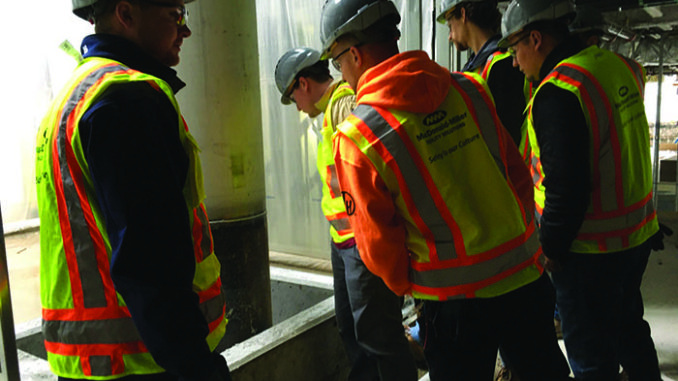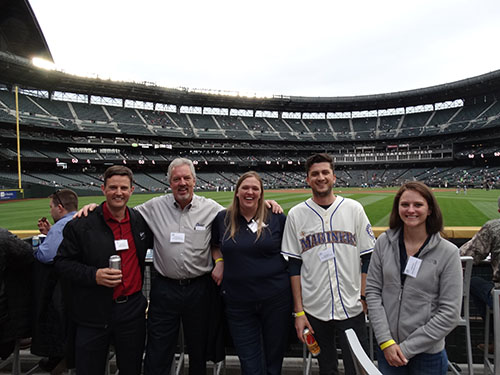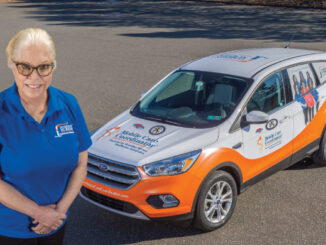
How supporting young leader committees is a win-win for every generation
By / Jessica Kirby • Photos courtesy of SMACNA-Western Washington
Recruitment, retention, mentoring. The future of the building trades depend on these principles, and connecting with and among the next generation of leadership is key to furthering the goals behind this mantra.
Connecting has changed over the years. Built on a system of master teaching the student, mentorship has evolved into a new concept, still rooted firmly in sharing knowledge and experience, but having branched out to include reciprocity and more flexible thinking. As a group experience, all participants have something to learn and something to share, and the outcome tends to be more relationship focused than ever.
Young leader committees foster this connection, bringing people together with activities, events, educational opportunities, and general fellowship, and easing the transition between generations to create the infrastructure for contemporary mentorship scenarios. Whether they are bringing new leaders together to brainstorm or connecting generations, committees are an essential part of moving an industry forward.
SMACNA-Western Washington’s Young Leaders Association (SMAC-YA) was founded in 2016 in an effort to get the next generation of “young associates” or industry leaders excited about the future of the sheet metal industry and membership in SMACNA-Western Washington. It consists of six to eight members with two co-chairs, and SMACNA-WW works to recruit a diverse committee that includes members from different backgrounds, company sizes, and types.
The committee is co-chaired by Rylan MacCay, operations manager at MacDonald-Miller, and Trenton Fluetsch, vice-president of operations at Sunset Air Inc. Both have been in the sheet metal industry for more than a decade and took on the co-chairing role to get to know people in the industry, collaborate on best practices, and encourage others to participate in SMACNA events.
“Our goal is to have an activity each quarter that reaches out to young professionals or people who may be interested in a HVAC industry career,” MacCay says. “Our committee’s guiding principle is to increase involvement of young professionals in SMACNA and assist with recruiting talented people into the industry.”
The committee achieves this with events that reach out to high school and college-students to educate them about HVAC industry and career opportunities. Some of these showcase a “day in the life” of a sheet metal worker and others are mentoring-style networking events where young professionals meet and mingle with experienced industry members.
In previous years, SMAC-YA hosted a college jobsite/fabrication tour, MLB game recruitment events, Happy Hours, and a holiday pub crawl. For 2021, the committee has planned a Mariners Game College Mixer on August 31. These events help build lasting business relationships that are the foundation of a thriving industry.

“This also includes recruiting and educating young talent outside of our trade,” Fluetsch says. “The SMAC-YA committee is important because it brings together young leaders to grow and develop so that the next generation of senior leadership will be in the greatest position to succeed.”
MacCay says the committee’s work is important because it brings professionals at all career stages together and adds diversity of perspective.
“The senior members of SMACNA have a wealth of knowledge, and as these members begin to transition, it is critical this knowledge be passed on to the next generation,” he says.
For individuals new to the industry and with leadership aspirations, committees like SMAC-YA can be a sounding board for all those questions members may feel more comfortable asking their peers.
“The committee allows for great networking opportunities between yourself and other young leaders in the industry,” Fluetsch says. “Being part of SMAC-YA also means you have a group of industry peers that you can ask judgement-free questions to and get a new perspective and feedback, which is invaluable.”
Recruitment might be the most important aspect of young leader committees. Despite a slowing economy due to the COVID-19 pandemic, construction is still booming nationally and is predicted to grow by 3% annually over the next decade. There is also a growing need for qualified craftspeople to fill in for the current workforce nearing retirement age.
Following the initial furloughs caused by the COVID-19 pandemic, getting back to appropriate labor levels within SMACNA-WW companies certainly was a struggle, but it also afforded an important opportunity to develop awareness around labor needs into the future and how young leaders can help.
“It opened our collective eyes into understanding the need for quality labor and the importance of filling our pipeline of labor for years to come,” Fluetsch says.
Employers also have much to gain from promoting and supporting young leader committees and from encouraging new recruits to become involved in SMACNA events, says Nathan Marsh, engineering manager for Holmberg Mechancial and honorary SMAC-YA Elder.
“Being part of a committee provides employees with the opportunity to work on their leadership skills and observe other emerging leaders in action,” he says. “The experiences and skills gained are brought back to the employers where they can be used to improve business operations.”
Serving on a committee creates opportunities for younger employees to meet, interact, and develop relationships with their peers throughout the industry. These relationships provide a platform for discussions and sharing of information about industry trends and best practices which, when applied to the business, can help to drive improvements in culture, efficiency, and quality.
“By allowing their employees to dedicate time to promoting their industry through committees, the employers benefit by having young people recruited in to join the industry who might have otherwise gone in a different career path,” Marsh says. “These new recruits can help to address short-term labor shortages while also creating the next generation of high performing employees.”
This summer, SMACNA-WW member Hermanson Company is offering students a unique opportunity to test the construction trades through the Heavy Metal Summer Experience 2021, a six-week fun and educational hands-on workshop.
The company is hosting ten students from Auburn School District for #HeavyMetalSummer workshops, designed to introduce underserved high school students to job opportunities in mechanical construction. Students will learn the basics of sheet metal, piping, and plumbing through twelve 2.5-hour training sessions led by construction professionals.
This pilot program, hosted at Hermanson Company’s shop facilities in Kent and at Western Allied Mechanical in Menlo Park, California, is partially funded by SMACNA-Western Washington and Construction for Change.
“This interactive and instructive experience is a perfect opportunity for young adults to learn about the variety of career options and numerous benefits available to them in the trades,” said Rick Hermanson, CEO of Hermanson Company. “We are giving teens the chance to test equipment, build unique projects they can take home, and to learn about the trades from people who are passionate about their work and succeeding in their careers. We’re proud to participate in the inaugural year of the HMSE and are excited to work alongside the students this summer.”
Programs like the HMSE are another tool in the toolbelt for contractors who are working toward successful recruitment initiatives that promote awareness of career options for students not focused on the college or university track. The hope is to reach a more diverse group of potential tradespeople and to create more diversity within the building trades workforce.
Thanks to generous donations from partners and sponsors, HMSE will provide each student with work boots on their first day in #HeavyMetalSummer to wear for the entire experience and beyond, standard construction industry personal protection equipment (hard hat, vest, safety glasses, and gloves) and a full tool-kit to fill out the toolboxes they will build. The tools are theirs to take home at graduation.
“The impact SMAC-YA has had on recruitment has been immeasurable,” MacCay says. “The committee has also been a helpful conduit to get younger professionals involved with SMACNA-Western Washington and SMACNA. Many of the SMAC-YA committee members have branched out to serve on other SMACNA committees, and member meeting attendance for younger people has increased as a result.”
Learn more about SMAC-YA at smacnaww.org ▪



